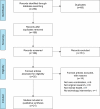Use of technology for care coordination initiatives for patients with mental health issues: a systematic literature review
- PMID: 30254446
- PMCID: PMC6143125
- DOI: 10.2147/NDT.S172810
Use of technology for care coordination initiatives for patients with mental health issues: a systematic literature review
Abstract
This systematic literature review investigates the use of technology for the coordination and management of mental health care with an emphasis on outcomes. Searches of MEDLINE/PubMed, Scopus, and EMBASE were conducted between January 1, 2003, and January 4, 2018, to identify articles that assessed patient outcomes associated with care coordination, evaluated technology to improve care, or discussed management of mental health care using technology. A total of 21 articles were included in a qualitative review based on the recommendations set forth by the PRISMA statement. Among the various health technologies, electronic health records were most commonly used for care coordination, with primary care being the most frequent setting. Care coordination was shown to provide easier patient access to health care providers and to improve communication between caregiver and patient, especially in cases where geographic location or distance is a challenge. Barriers to coordinated care included, but were not limited to, insufficient funding for health information technology, deficient reimbursement plans, limited access to technologies, cultural barriers, and underperforming electronic health record templates. In conclusion, many studies showed the benefit of coordinated and collaborative care through the use of technology; however, further research and development efforts are needed to continue technological innovation for advanced patient care.
Keywords: behavioral health; collaborative care; depression; health information technology; schizophrenia; serious mental illness.
Conflict of interest statement
Disclosure Erin Falconer is an employee of ODH, Inc.; David Kho was an employee of ODH, Inc. at the time the work was done. John P Docherty is an employee of Otsuka America Pharmaceutical, Inc. The authors report no other conflicts of interest in this work.
Similar articles
-
Promoting and supporting self-management for adults living in the community with physical chronic illness: A systematic review of the effectiveness and meaningfulness of the patient-practitioner encounter.JBI Libr Syst Rev. 2009;7(13):492-582. doi: 10.11124/01938924-200907130-00001. JBI Libr Syst Rev. 2009. PMID: 27819974
-
Patient Portals Facilitating Engagement With Inpatient Electronic Medical Records: A Systematic Review.J Med Internet Res. 2019 Apr 11;21(4):e12779. doi: 10.2196/12779. J Med Internet Res. 2019. PMID: 30973347 Free PMC article.
-
Telemedicine for the Medicare population: pediatric, obstetric, and clinician-indirect home interventions.Evid Rep Technol Assess (Summ). 2001 Aug;(24 Suppl):1-32. Evid Rep Technol Assess (Summ). 2001. PMID: 11569328 Free PMC article.
-
[Improving population mental health by integrating mental health care into primary care].Sante Ment Que. 2017 Spring;42(1):243-271. Sante Ment Que. 2017. PMID: 28792571 Review. French.
-
How has the impact of 'care pathway technologies' on service integration in stroke care been measured and what is the strength of the evidence to support their effectiveness in this respect?Int J Evid Based Healthc. 2008 Mar;6(1):78-110. doi: 10.1111/j.1744-1609.2007.00098.x. Int J Evid Based Healthc. 2008. PMID: 21631815
Cited by
-
Clinical staging and the differential risks for clinical and functional outcomes in young people presenting for youth mental health care.BMC Med. 2022 Dec 14;20(1):479. doi: 10.1186/s12916-022-02666-w. BMC Med. 2022. PMID: 36514113 Free PMC article.
-
Health promotion and disease prevention in the education of health professionals: a mapping of European educational programmes from 2019.BMC Med Educ. 2022 Nov 11;22(1):778. doi: 10.1186/s12909-022-03826-5. BMC Med Educ. 2022. PMID: 36369021 Free PMC article.
-
Association of prescribed oral stimulants on cocaine use among patients enrolled in opioid agonist treatment: A retrospective longitudinal cohort study.Front Psychiatry. 2022 Dec 2;13:1074691. doi: 10.3389/fpsyt.2022.1074691. eCollection 2022. Front Psychiatry. 2022. PMID: 36532164 Free PMC article.
-
Revisiting the four core functions (4Cs) of primary care: operational definitions and complexities.Prim Health Care Res Dev. 2021 Nov 10;22:e68. doi: 10.1017/S1463423621000669. Prim Health Care Res Dev. 2021. PMID: 34753531 Free PMC article.
-
Psychotherapists' perspectives on collaboration and stepped care in outpatient psychotherapy-A qualitative study.PLoS One. 2020 Feb 5;15(2):e0228748. doi: 10.1371/journal.pone.0228748. eCollection 2020. PLoS One. 2020. PMID: 32023303 Free PMC article.
References
-
- Anderson P, Jané-Llopis E, Hosman C. Reducing the silent burden of impaired mental health. Health Promot Int. 2011;26(Suppl 1):i4–i9. - PubMed
-
- World Health Organization . The Global Burden of Disease: 2004 Update. Geneva, Switzerland: World Health Organization; 2008.
-
- World Health Organization . Depression and Other Common Mental Disorders: Global Health Estimates. Geneva, Switzerland: World Health Organization; 2017.
-
- National Council Medical Director Institute . The Psychiatric Shortage – Causes and Solutions. Washington, DC: National Council for Behavioral Health; 2017.
Publication types
LinkOut - more resources
Full Text Sources
Other Literature Sources


